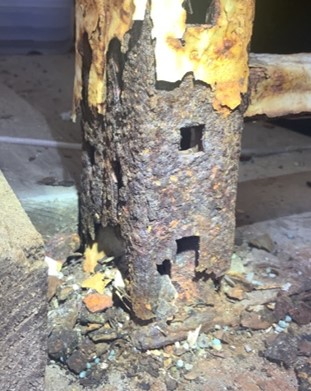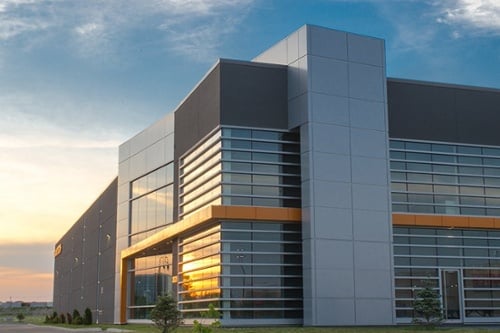3. Incorrect Reuse of Racks
Every racking system is designed to meet specific load capacities, configurations, and environmental conditions. Reusing racks from other projects without comprehensive engineering evaluation can introduce significant safety risks and increase the likelihood of unexpected failures. Factors such as altered load distribution, damaged components, or differences in floor conditions may render the reused system unsuitable for its new application.
Before repurposing racking systems, it is vital to consult with qualified engineers or the original equipment manufacturer (OEM) to reassess the system’s load capacity, structural integrity, and compliance with applicable safety standards, such as those set by RMI (Rack Manufacturers Institute). Additionally, inspecting all components for damage, corrosion, or wear and ensuring proper assembly according to engineering specifications are critical steps in maintaining system safety and performance.
4. Corrosion
Corrosion is a silent but significant threat to the structural integrity of racking systems. Over time, prolonged exposure to moisture, chemicals, or extreme temperatures can degrade steel components, reducing their load-carrying capacity and increasing the risk of rack failure. Corrosion often begins in hard-to-see areas, such as at the base of columns or around anchor points, making it critical to address even minor signs of deterioration promptly.
Implementing a proactive maintenance program is essential to combat corrosion and maintain long-term racking integrity. This includes routine inspections to identify early signs of corrosion, the application of protective coatings or galvanization for high-risk environments, and the timely repair or replacement of compromised components. Additionally, ensuring that the warehouse environment is well-ventilated and minimizing exposure to corrosive substances can further help preserve the lifespan of your racking systems.

5. Racking Setup Errors
Installing a racking system is a precise and technical process that requires strict adherence to engineering specifications and industry standards. Poor installation practices—such as using substandard materials or failing to follow manufacturer guidelines—can lead to structural weaknesses and significantly increase the risk of rack failure.
Ensuring every component is installed correctly, anchored securely, and aligned adequately is critical for preventing pallet rack failure. This includes checking for accurate beam heights according to your engineering documentation , ensuring all columns are anchored correctly to the floor, and verifying that bracing and base plates are installed per the system’s design specifications. This includes checking for accurate beam heights according to your engineering documentation, ensuring all columns are anchored correctly to the floor, verifying that bracing and base plates are installed per the system’s design specifications, and checking if the beam is clipped in fully and secured using safety pins.
Additionally, using certified installers and conducting a post-installation inspection can help identify and address potential issues before they escalate. Adhering to recognized standards, such as those established by the Rack Manufacturers Institute (RMI), is essential for compliance and safety.
Conclusion: Preventing Warehouse Rack Failure
Preventing pallet rack failure requires a proactive approach that combines immediate damage mitigation, adherence to strict safety standards, and investment in expert engineering solutions. Regular inspections, professional assessments, and prompt, qualified repairs are critical for maintaining the integrity and safety of your warehouse racking systems.
Rack failures are rarely the result of a single issue; they are often caused by a combination of factors, such as improper maintenance, poor installation, or overlooked damage. Getting the help of professional experts ensures that your racking is thoroughly evaluated and maintained according to industry best practices and applicable standards.
By understanding the common causes of rack failure and implementing rigorous safety protocols with expert guidance, you can minimize risks, protect your employees, and safeguard your warehouse operations from costly and hazardous collapses. Proactive measures, such as reinforcing vulnerable areas and addressing potential hazards early, are key to extending the lifespan of your racking system and ensuring operational efficiency.
Frequently Asked Questions (FAQ) About Pallet Rack Failure
What is racking failure?
Warehouse rack failure occurs when a racking system collapses or loses structural integrity, often leading to severe damage, inventory loss, and safety hazards. Common causes include overloading, impact damage, improper installation, and corrosion, all of which can compromise the system’s stability.
What are the most common causes of pallet rack failure?
The most common causes of rack failure include forklift impacts, improper load distribution, corrosion, incorrect reuse of racks, overloading, and errors during setup. Each of these factors reduces the structural integrity of the racking system and increases the likelihood of collapse if not promptly addressed.
How can I prevent rack failure in my warehouse?
To prevent rack failure, implement regular inspections, promptly repair or replace damaged components, follow posted load limits, and ensure all components meet industry standards. Using certified installers, providing training for forklift operators, and investing in protective solutions, such as column guards, can also significantly reduce risks.
What should I do if I suspect a racking system is at risk of failure?
If you suspect a racking system is at risk of failure, immediately unload the affected area and contact a qualified engineer or racking professional for a thorough inspection. Avoid attempting repairs without consulting an expert, as improper fixes can exacerbate the problem and create additional safety hazards.
Can reused or relocated racks cause failure?
Yes, reusing or relocating racks without proper re-engineering can lead to pallet rack failure. Each location and application has its unique requirements, including variations in load distribution, seismic activity, and operational dynamics. Moving a rack without recalculating load capacities, stress factors, and anchoring requirements can compromise its structural integrity. Consulting with a qualified engineer is essential to ensure the relocated racks meet safety and performance standards.
What are the warning signs of an impending rack failure?
Warning signs include visible damage to beams or columns, leaning or misaligned racks, cracks in welds or footplates, excessive rust or corrosion, and missing or improperly installed beam connectors or safety pins. Regular inspections conducted by trained professionals are critical for identifying these red flags early and addressing them before they escalate.
What role do load plaques play in preventing rack failure?
Load plaques display critical information about each rack system’s maximum load capacity and configuration. Ensuring that load plaques are clearly visible, accurate, and up-to-date helps employees understand the racks’ limits and avoid overloading, one of the leading causes of failure. Regularly verifying the accuracy of load plaques, especially after system modifications, is crucial for maintaining safety.
While this FAQ covers many of the technical aspects of pallet rack failure, we understand navigating all the details on your own can feel overwhelming. Every warehouse is unique, and addressing your specific concerns is key to maintaining a safe and efficient operation.
Don’t hesitate to reach out if you have additional questions or need guidance tailored to your racking system. Our experts are here to help you assess, repair, and enhance your racking infrastructure. Message us today to discuss your needs and ensure your warehouse is equipped to prevent rack failure.










